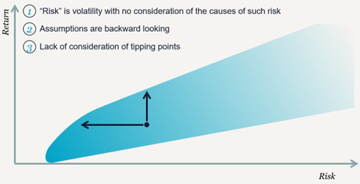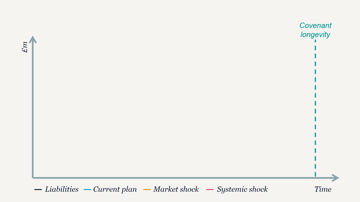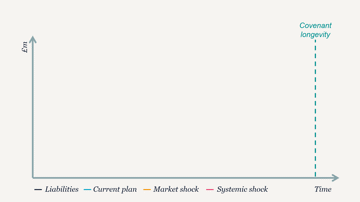Creakonomics: why you should care about systemic risks - Part I
This content is AI generated, click here to find out more about Transpose™.
For terms of use click here.

Cast your mind back to 2011. The Eurozone was engulfed in a sovereign debt crisis, with Greece at its core, teetering on the brink of default. Banks heavily exposed to government debt face massive losses, liquidity dries up and economic activity suffers, driving sovereign yields even higher. The financial system could no longer function effectively without intervention and the ripple effect from this crisis threatens global markets and, in turn, pension schemes. That risk, which once seemed remote, had suddenly become all too real.
Now, you might be thinking there’s little you can do about a scenario like this. I get it… “Jacob, you can’t simply diversify systemic risks away. You can’t easily hedge them. It’s all very difficult – essentially, they’re unavoidable”.
However, across this two-part blog, Tom Fieldsend and I are going to try and change your mind. Yes - systemic risks can knock you off course. But you can, and should, do something to reduce both the likelihood and severity of these risks. Doing so is:
- good risk management
- right for members; and
- part of your duties as trustees or indeed as a sponsor.
What do I mean when we talk about systemic risks here? I’ll keep it brief, but I mean risks that do not just affect the financial performance of one company, or asset class, but can instead impact the performance of an entire financial system and even undermine the stability of financial markets. They are often interconnected and can also originate outside the financial system, such as anti-microbial resistance or climate risk.
Addressing systemic risks is good risk management
The below chart is one you may have used when you last reviewed your investment strategy. It’s a risk-return chart and, as investors, you’re generally looking to maximise risk-adjusted returns by moving your current portfolio (shown by the blue dot) to the left or upwards to the frontier of the blue area (the range of all possible portfolios you can invest in).

However, there’s a problem here. Nowhere in this chart does it allow you to consider and manage systemic risks. For example:
- In this model, the manifestation of risk is the variability of prices, but the causes of such risk such as climate change or pandemics are not considered by the maths. Forget systemic risks for the moment, this chart ignores a whole sea of risks that investors should generally consider, such as liquidity risk, reinvestment risk and counterparty risk.
- The assumptions behind this chart are all based on backward looking, historical data. This naturally means systemic risks are not captured because of a lack of data.
- More generally, these risks can be difficult to capture in the assumptions due to a lack of full understanding on how they might play out or consideration of “tipping points” where trends can’t be fully reversed.
Because these risks are complex, traditional risk models don’t capture them well – they require more specific attention instead.
Addressing systemic risks is the right thing for members
My second argument is that this is right for members. Your job is to ultimately make sure your member’s pensions get paid.
Let’s pretend I have a severe market shock (orange line in the chart below). My assets fall in value and the funding position worsens. However, I am still able to get back to full funding. Granted, I get there a bit later, which shows I need to be flexible with my time period (which is probably no bad thing).

Now imagine a systemic shock (pink line below).
- Firstly, the shock is larger. Systemic risks can impact all parts of your portfolio and dwarf the other risks you’re running.
- Secondly, unlike regular fluctuations, a systemic shock can disrupt the entire financial ecosystem, affecting long-term economic stability and seriously damaging economic growth. In this scenario, not only have I had a permanent loss of value, there is also no significant market bounce back like I had with the orange line above.
- Finally, I said earlier that systemic risks can be interconnected. In the shock I’ve modelled, we may have had a step change in longevity expectations for example. Or perhaps corporate Britain is significantly impacted and the covenant is now much weaker. Or both! In this shock, it is not just my asset value that changes. It is the entire financial system that my pension scheme operates in that is in flux, which threatens your ability to pay members benefits.

To illustrate this difference, imagine waiting for a train that gets cancelled. It’s inconvenient, but another train will arrive, and you’ll reach your destination eventually. That’s a normal market shock.
Now imagine a tube strike. It doesn’t matter how long you wait at your station. No tube is coming and you’re not getting to your destination! However, there’s also been a sort of domino effect. If you leave the tube station, you find the buses are jam packed and you can’t get on. There are no cabs available, and the roads are busy. The entire transport system has been undermined. That’s a systemic shock.
Many systemic risks also impact on quality of life. By taking action to manage or even better mitigate systemic risks, you not only help improve the chance of paying members pensions, but you can also contribute to a stable financial future where pensioners enjoy real purchasing power, economic stability and better quality of life.
Addressing systemic risks is part of your duty
Finally, addressing systemic risk isn’t just a theoretical exercise - it’s increasingly recognised as a core responsibility for pension scheme trustees and sponsors. Recent guidance such as the General Code, the DB Funding Code and the Financial Markets Law Committee report all explicitly reference systemic risks. You wouldn’t ignore a crack in the foundations of your house – so why ignore the cracks in the financial system?
The call to action
When we ignore systemic risks or treat them as inevitable, we leave ourselves vulnerable. Instead, we all need to start thinking more about managing these risks and better protecting the financial health of our pension schemes and ultimately scheme members.
So, what next? Well, check out part 2 of this blog written by my colleague Tom Fieldsend to find out what actual steps you can take to better manage systemic risks.
This blog is a summary of the talk “Creakonomics: all it would take is a push” given at our Annual DB conference in November 2024.
Subscribe to our thinking
Get relevant insights, leading perspectives and event invitations delivered right to your inbox.
Get started to select your preferences.






